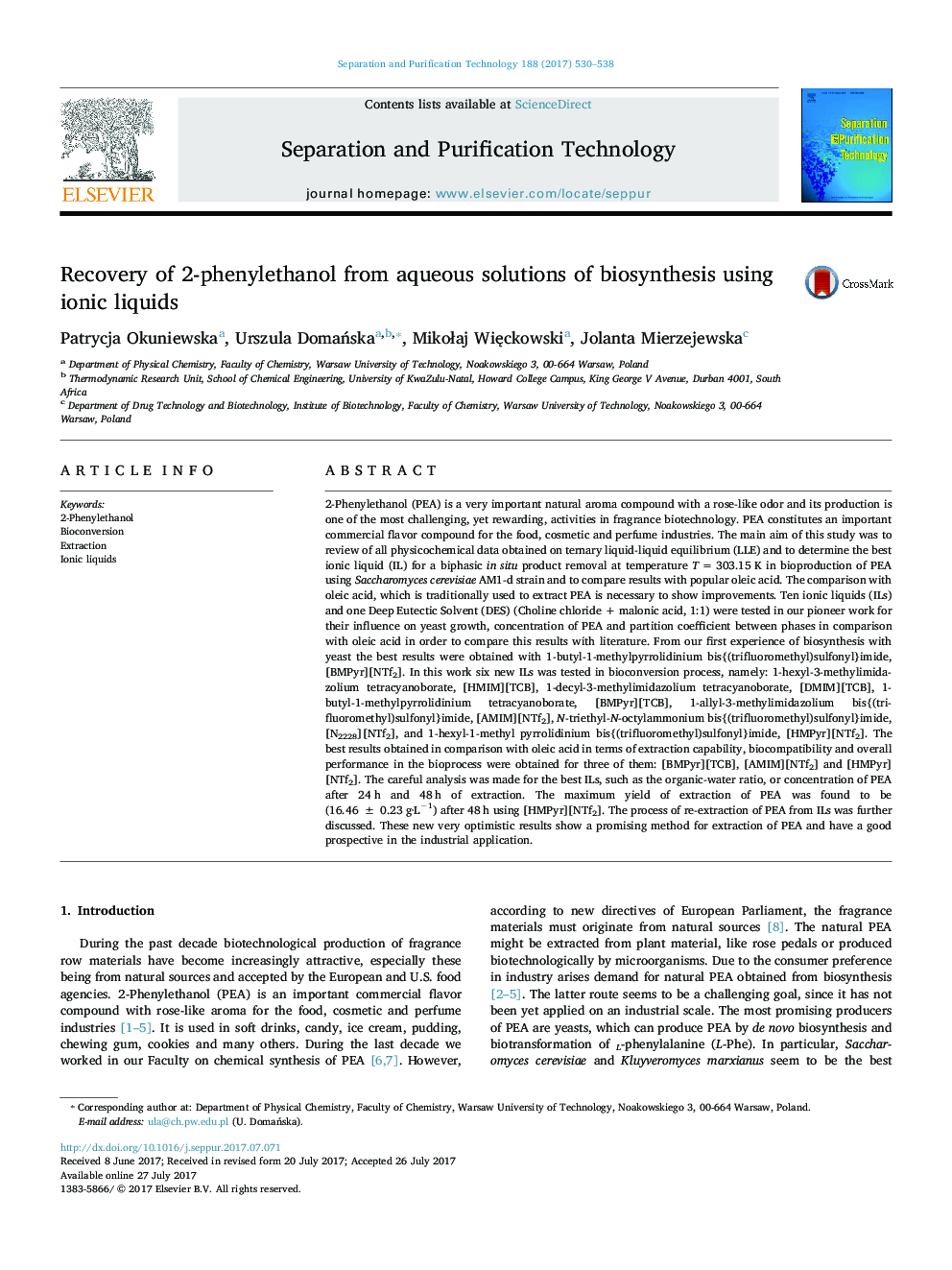| کد مقاله | کد نشریه | سال انتشار | مقاله انگلیسی | نسخه تمام متن |
|---|---|---|---|---|
| 4989830 | 1456932 | 2017 | 9 صفحه PDF | دانلود رایگان |
- Review of ternary LLE in systems of (ILÂ +Â 2-phenylethanol, PEAÂ +Â water).
- Bioconversion of L-Phe to PEA using Saccharomyces cerevisiae AM1-d strain.
- The extraction of PEA with six ILs after 24Â h and 42Â h.
- The comparison of entrainers with oleic acid.
- Re-extraction of IL.
2-Phenylethanol (PEA) is a very important natural aroma compound with a rose-like odor and its production is one of the most challenging, yet rewarding, activities in fragrance biotechnology. PEA constitutes an important commercial flavor compound for the food, cosmetic and perfume industries. The main aim of this study was to review of all physicochemical data obtained on ternary liquid-liquid equilibrium (LLE) and to determine the best ionic liquid (IL) for a biphasic in situ product removal at temperature T = 303.15 K in bioproduction of PEA using Saccharomyces cerevisiae AM1-d strain and to compare results with popular oleic acid. The comparison with oleic acid, which is traditionally used to extract PEA is necessary to show improvements. Ten ionic liquids (ILs) and one Deep Eutectic Solvent (DES) (Choline chloride + malonic acid, 1:1) were tested in our pioneer work for their influence on yeast growth, concentration of PEA and partition coefficient between phases in comparison with oleic acid in order to compare this results with literature. From our first experience of biosynthesis with yeast the best results were obtained with 1-butyl-1-methylpyrrolidinium bis{(trifluoromethyl)sulfonyl}imide, [BMPyr][NTf2]. In this work six new ILs was tested in bioconversion process, namely: 1-hexyl-3-methylimidazolium tetracyanoborate, [HMIM][TCB], 1-decyl-3-methylimidazolium tetracyanoborate, [DMIM][TCB], 1-butyl-1-methylpyrrolidinium tetracyanoborate, [BMPyr][TCB], 1-allyl-3-methylimidazolium bis{(trifluoromethyl)sulfonyl}imide, [AMIM][NTf2], N-triethyl-N-octylammonium bis{(trifluoromethyl)sulfonyl}imide, [N2228][NTf2], and 1-hexyl-1-methyl pyrrolidinium bis{(trifluoromethyl)sulfonyl}imide, [HMPyr][NTf2]. The best results obtained in comparison with oleic acid in terms of extraction capability, biocompatibility and overall performance in the bioprocess were obtained for three of them: [BMPyr][TCB], [AMIM][NTf2] and [HMPyr][NTf2]. The careful analysis was made for the best ILs, such as the organic-water ratio, or concentration of PEA after 24 h and 48 h of extraction. The maximum yield of extraction of PEA was found to be (16.46 ± 0.23 g·Lâ1) after 48 h using [HMPyr][NTf2]. The process of re-extraction of PEA from ILs was further discussed. These new very optimistic results show a promising method for extraction of PEA and have a good prospective in the industrial application.
183
Journal: Separation and Purification Technology - Volume 188, 29 November 2017, Pages 530-538
